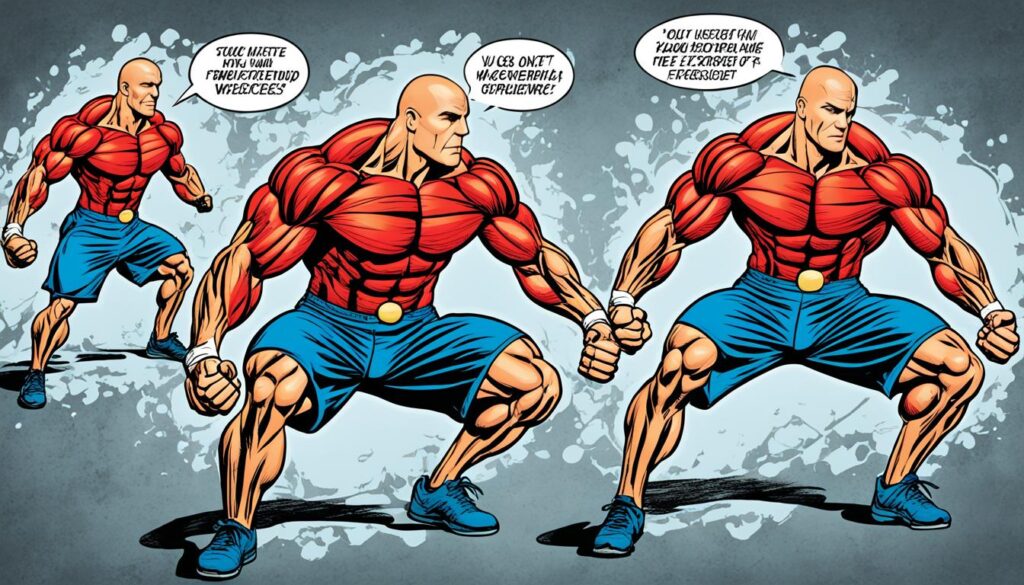Complete Guide: kettlebell swings muscles worked
If you’re looking for a workout that can deliver exceptional results, look no further than kettlebell swings. Did you know that kettlebell swings engage multiple muscle groups in your body simultaneously, making them one of the most efficient exercises you can do?
Kettlebell swings offer a full-body workout that can elevate your strength training routine to the next level. In this comprehensive guide, I will walk you through the benefits and muscles worked during kettlebell swings. Let’s explore how this dynamic exercise can help you build strength and condition your body.
Key Takeaways:
- Kettlebell swings engage multiple muscle groups in your body simultaneously.
- They provide a full-body workout that can elevate your strength training routine.
- The key muscles worked during kettlebell swings include the glutes, hamstrings, quads, core muscles, lower back, shoulders, forearms, and grip.
- Incorporating kettlebell swings into your routine can improve strength, power, and overall conditioning.
- Give kettlebell swings a try and experience the incredible benefits for yourself!
Understanding Kettlebell Swings
Before we dive into the specific muscles worked during kettlebell swings, let’s take a moment to understand what these exercises entail. Kettlebell swings are a dynamic movement that involves swinging the kettlebell from between the legs up to shoulder height. This explosive exercise targets multiple muscle groups simultaneously and is a staple in many strength training programs.
When performing kettlebell swings, you engage your entire body, making it a highly effective full-body workout. The movements require a combination of strength, power, and coordination, making them ideal for individuals looking to improve their overall fitness level.
“Kettlebell swings are one of the most versatile exercises that target multiple muscle groups while providing cardiovascular benefits. They help build strength, improve mobility, and promote explosive power.”
One of the distinguishing features of kettlebell swings is the hip hinge movement involved. By bending forward at the hips and generating power from the posterior chain, which includes the glutes, hamstrings, and lower back, you can generate maximum force as you swing the kettlebell. This explosive movement not only builds strength in the targeted muscles but also facilitates conditioning and power development throughout the entire body.
The benefits of kettlebell swings extend beyond strength and power development. Due to the dynamic and repetitive nature of the exercise, kettlebell swings also promote cardiovascular endurance and calorie burn, making them an excellent choice for those looking to improve their overall fitness.
In the next section, we will delve into the specific muscles worked during kettlebell swings and explore the comprehensive engagement of multiple muscle groups that make this exercise a favorite among fitness enthusiasts.
Key Muscles Engaged in Kettlebell Swings
When performing kettlebell swings, you engage several major muscle groups throughout your body. The primary muscles worked include the glutes, hamstrings, quads, core muscles, and lower back. Additionally, kettlebell swings also activate the shoulders, forearms, and grip muscles due to the dynamic nature of the exercise. This comprehensive engagement of multiple muscle groups makes kettlebell swings an efficient full-body workout.
Here’s a breakdown of the key muscles involved in kettlebell swings:
- Glutes: The glute muscles, including the gluteus maximus, medius, and minimus, are responsible for extending the hips during the swing. They play a crucial role in generating power and force.
- Hamstrings: The hamstring muscles, located at the back of the thighs, work together with the glutes to drive the kettlebell swing motion. They play a vital role in hip extension.
- Quads: The quadriceps, located at the front of the thighs, help stabilize the knees during the swing and assist in the upward phase of the movement.
- Core Muscles: Kettlebell swings heavily engage the core muscles, including the rectus abdominis, obliques, and deep stabilizers. These muscles provide stability and control throughout the exercise.
- Lower Back: The erector spinae muscles, located along the spine, are responsible for maintaining a neutral spine position during the swing. They help protect the lower back from strain.
- Shoulders: The deltoid muscles of the shoulders are activated during the upward phase of the kettlebell swing, as they assist in lifting the kettlebell to shoulder height.
- Forearms: The muscles of the forearms, including the flexors and extensors, are engaged to maintain a firm grip on the kettlebell throughout the movement.
- Grip Muscles: The grip muscles, comprising the muscles of the hands and fingers, work to hold onto the kettlebell securely. They are continuously challenged during kettlebell swings.
By targeting these major muscle groups simultaneously, kettlebell swings provide a comprehensive full-body workout that can help enhance strength, power, and conditioning.

| Muscle Group | Muscles Worked |
|---|---|
| Glutes | Gluteus maximus, gluteus medius, gluteus minimus |
| Hamstrings | Hamstring muscles |
| Quads | Quadriceps muscles |
| Core Muscles | Rectus abdominis, obliques, deep stabilizers |
| Lower Back | Erector spinae muscles |
| Shoulders | Deltoid muscles |
| Forearms | Forearm flexors and extensors |
| Grip Muscles | Hand and finger muscles |
Benefits of Kettlebell Swings for Strengthening and Conditioning
Incorporating kettlebell swings into your strength training routine can offer a range of benefits. Firstly, kettlebell swings help strengthen the posterior chain, which includes the glutes, hamstrings, and lower back. This can significantly improve your performance in exercises like squats and deadlifts.
Secondly, the explosive nature of kettlebell swings enhances power production, making it an excellent exercise for athletes looking to improve their performance in sports such as sprinting or jumping.
Lastly, the grip strength required during kettlebell swings can improve overall grip strength, benefiting exercises like bench presses and pull-ups.
| Benefits of Kettlebell Swings | Worked Muscles |
|---|---|
| Strengthens the posterior chain | Glutes, Hamstrings, Lower Back |
| Enhances power production | N/A |
| Improves grip strength | Forearms, Grip Muscles |
By incorporating kettlebell swings into your strength training routine, you can experience these benefits and elevate your overall performance and conditioning. The targeted strengthening and conditioning provided by kettlebell swings make it a valuable addition to any fitness regimen.
The Posterior Chain: Key to Strength and Stability
“The posterior chain, which includes the glutes, hamstrings, and lower back, plays a crucial role in overall strength and stability. Investing time and effort into strengthening these muscles through exercises like kettlebell swings can have a significant impact on your athletic performance.” – Fitness Expert
Don’t miss out on the benefits of kettlebell swings. Start incorporating this dynamic exercise into your strength training routine to strengthen your posterior chain, enhance power production, and improve grip strength.
Conclusion
Kettlebell swings offer an effective and efficient way to achieve a complete full-body workout. By engaging multiple muscle groups simultaneously, including the glutes, hamstrings, quads, core muscles, lower back, shoulders, forearms, and grip, this dynamic exercise targets and strengthens key areas of the body.
Incorporating kettlebell swings into your strength training routine can yield numerous benefits. This exercise enhances strength, power, and conditioning, making it a valuable addition to any fitness regimen. Whether you are an athlete aiming to improve performance or an individual seeking to elevate your workout routine, kettlebell swings can help you achieve your goals.
Make the most out of your workouts by including kettlebell swings in your training sessions. Embrace the challenge and experience firsthand the transformative impact this exercise can have on your overall fitness and well-being. Elevate your strength, enhance your power, and improve your conditioning with the versatile and effective kettlebell swing.
FAQ
What muscles does kettlebell swings work?
Kettlebell swings engage multiple muscle groups throughout the body. The primary muscles worked include the glutes, hamstrings, quads, core muscles, and lower back. Additionally, the shoulders, forearms, and grip muscles are also activated.
How do kettlebell swings contribute to strength training?
Incorporating kettlebell swings into your strength training routine offers various benefits. It strengthens the posterior chain, including the glutes, hamstrings, and lower back, which can enhance performance in exercises like squats and deadlifts. The explosive nature of kettlebell swings also improves power production, making it ideal for athletes looking to enhance sprinting or jumping abilities. Moreover, the exercise improves grip strength, which is beneficial for exercises like bench presses and pull-ups.
